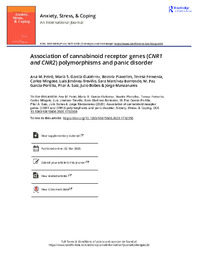Por favor, use este identificador para citar o enlazar este ítem:
https://hdl.handle.net/11000/35354Registro completo de metadatos
| Campo DC | Valor | Lengua/Idioma |
|---|---|---|
| dc.contributor.author | Peiró, Ana | - |
| dc.contributor.author | García Gutiérrez, María Salud | - |
| dc.contributor.author | Planelles, Beatriz | - |
| dc.contributor.author | Femenía Cantó, Teresa | - |
| dc.contributor.author | Mingote, Carlos | - |
| dc.contributor.author | Jiménez Treviño, Luis | - |
| dc.contributor.author | Martínez Barrondo, Sara | - |
| dc.contributor.author | García Portilla, M. Paz | - |
| dc.contributor.author | Saiz, Pilar A. | - |
| dc.contributor.author | Bobes, Julio | - |
| dc.contributor.author | Manzanares, Jorge | - |
| dc.contributor.other | Departamentos de la UMH::Farmacología, Pediatría y Química Orgánica | es_ES |
| dc.date.accessioned | 2025-01-27T12:25:55Z | - |
| dc.date.available | 2025-01-27T12:25:55Z | - |
| dc.identifier.citation | Anxiety, Stress and Coping, 2020;33(3):256-265 | es_ES |
| dc.identifier.issn | 1061-5806 | - |
| dc.identifier.issn | 1477-2205 | - |
| dc.identifier.uri | https://hdl.handle.net/11000/35354 | - |
| dc.description.abstract | Background and objectives: Panic disorder (PD) is an anxiety disorder characterized by recurrent and unexpected panic attacks along with sudden onset of apprehension, fear or terror. The endocannabinoid system (ECS) has a role in stress recovery, regulating anxiety. The aim of this study was to analyze potential genetic alterations in key ECS targets in patients suffering from panic disorders. Design and methods: We analyzed single nucleotide polymorphisms (SNPs) of the cannabinoid receptors (CNR1; CNR2) and the endocannabinoid hydrolytic enzyme fatty acid amide hydrolase (FAAH) genes in 164 Spanish PD patients and 320 matched controls. Results: No significant differences were observed in the SNPs of the CNR2 and FAAH genes tested. However, when analyzing genotype-by-sex interaction at A592G (rs2501431) and C315T (rs2501432) in the CNR2 gene, the presence of the G-allele in males was associated with a protective haplotype. Genotyping analysis revealed that variants in CNR1 confer vulnerability to PD, with a significantly increased risk associated with the G-allele (rs12720071) and C-allele (rs806368). This finding was consistent when analyzing genotype-by-sex interaction, where females presented a greater PD risk. Conclusions: Polymorphisms at the CNR1 gene may be a risk factor for PD contributing to sex-specific dysfunction in females. | es_ES |
| dc.format | application/pdf | es_ES |
| dc.format.extent | 11 | es_ES |
| dc.language.iso | eng | es_ES |
| dc.publisher | Taylor & Francis | es_ES |
| dc.rights | info:eu-repo/semantics/openAccess | es_ES |
| dc.rights | Attribution-NonCommercial-NoDerivatives 4.0 Internacional | * |
| dc.rights.uri | http://creativecommons.org/licenses/by-nc-nd/4.0/ | * |
| dc.subject | Panic disorder | es_ES |
| dc.subject | panic attacks | es_ES |
| dc.subject | CNR1 | es_ES |
| dc.subject | CNR2 | es_ES |
| dc.subject | FAAH | es_ES |
| dc.subject | single nucleotide polymorphism | es_ES |
| dc.subject.other | CDU::6 - Ciencias aplicadas::61 - Medicina::615 - Farmacología. Terapéutica. Toxicología. Radiología | es_ES |
| dc.title | Association of cannabinoid receptor genes (CNR1 and CNR2) polymorphisms and panic disorder | es_ES |
| dc.type | info:eu-repo/semantics/article | es_ES |
| dc.relation.publisherversion | 10.1080/10615806.2020.1732358 | es_ES |

Ver/Abrir:
Association of cannabinoid receptor genes (CNR1 and CNR2) polymorphisms and panic disorder.pdf
1,07 MB
Adobe PDF
Compartir:
 La licencia se describe como: Atribución-NonComercial-NoDerivada 4.0 Internacional.
La licencia se describe como: Atribución-NonComercial-NoDerivada 4.0 Internacional.
.png)